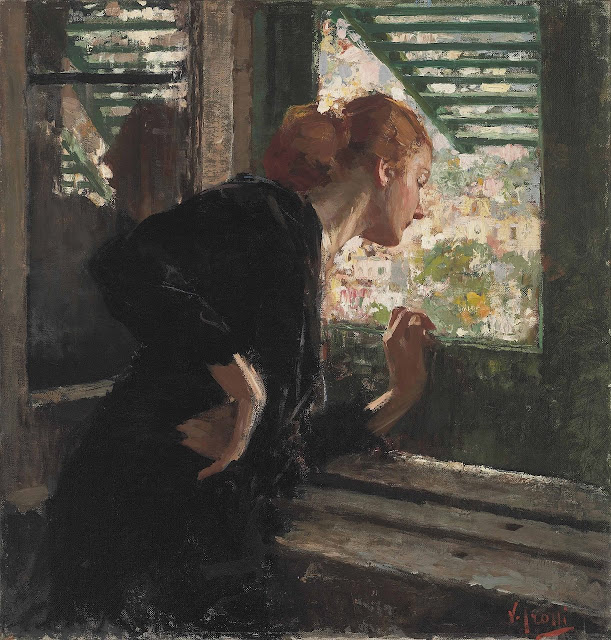Northern Italian School (ca. 1520)
.
Jan Victors (1640)
.
Adreiaen van Ostade - Spinning Woman (1650)
.
Johannes Vermeer - Girl Reading a Letter (ca. 1659)
.
Gerard Dou - Maid (1660)
.
Bartolomé Esteban Murillo (ca. 1660)
.
Abraham van Strij - Old Woman Reading
.
Caspar David Friedrich (1822)
.
William Etty - Window in Venice During a Fiesta (1831)
.
Ferdinand Georg Waldmüller (1840)
.
Vasily Tropinin (1841)
.
Alfred Stevens (1859)
.
Gustave Courbet (1865)
.
Berthe Morisot - Artist's Sister (1869)
.
Edgar Degas (1872)
.
Raimundo Madrazo (ca. 1875)
.
Camille Pissarro (1879)
.
Gustave Caillebotte (1880)
.
Giuseppe De Nittis (1883)
.
Henry La Thangue (undated)
.
Robert Lewis Reid (1885)
.
Vilhelm Hammershoi (1885)
.
Paul Gauguin (1880)
.
Hans Heyerdahl (1880)
.
Alfred Stevens (undated)
.
Fritz von Uhde - Dressmaker (1890)
.
Ferdinand Hodler (1890)
.
Lilla Cabot Perry - Edith, the Artist's Granddaughter (1891)
.
Tivadar Csontvary Kosztka (1895)
.
Pierre Bonnard (1898)
.
Carl Vilhelm Holsoe (ca. 1900)
.
Vincenzo Irolli (ca. 1900)
.
Mary Cassatt (1902)
.
Thomas Kennington - Woman Reading (1900s)
.
Edouard Vuillard (1908)
.
Gwen John - Woman Sewing
.
Jean Metzinger (1914)
.
Rik Wouters (1915)
.
Frederick Carl Frieseke (ca. 1915)
.
Pierre-Auguste Renoir - ... View of Nice (1918)
.
Gerda Wegener (1920)
.
Henri Lebasque (1920)
.
Childe Hassam - Easter Morning (1921)
.
Henri Matisse (1921)
.
Aksel Johannessen - Asa, the Artist's Daughter (1922)
.
Boris Kustodiev (1923)
.
Salvador Dali (1925)
.
Suzanne Valadon (1926)
.
Julio Romero de Torres (1927)
.
Paul Delvaux (1936)
.
Pablo Picasso (1936)
.
Gustave De Smet (1938)
.
Prudence Heward (1941)
.
Edward Hopper - Hotel Window (1955)
.
Look through any window: what do you see?
Here are some examples of paintings where a window plays an important role in the composition. What is the function of a window: it forms the separation between inside and outside, moreover it gives us a view of the other side. The perspective can change. There are paintings where we as spectators stand outside and see a woman through the window. Sometimes we can look a little further inward to get an impression of what is going on there. But more often the painter chooses to place us as a spectator inside, together with the woman. One time we see the woman on the back and look out together with her, another time we see her from the side, or in the face and she is busy with something and doesn’t notice what may be going on outside.
Sometimes we don't get to see what's out there at all, like the painting of Hodler. We can only see it through the woman’s eyes, the expression of her face. In other paintings the window only has a function in the play of dark and light…
But most of the time we are given a glimpse of what can be seen outside: a street with people, a boulevard with palm trees, a lake with a sailboat, a flowering garden... It gives us an impression of where we are, what the weather is, and it even may tell us more.
A good example of this is the painting by Lebasque, where we see a woman with a hood looking at a sailboat. Is it a fisherman's wife waiting for her husband's return after fishing at sea? It has all the appearance of it.
And what about Hopper's work? We see a neatly dressed woman in the lobby of her hotel looking out. It is dark outside, yet there is light on the woman's face and also on the column outside: the appearance of a street light? Is she waiting for a man, too?
Vermeer's painting also seems to tell a story. We see a girl reading a letter in front of an open window. The light falls on the letter from the outside. But is that the only reason she's standing there in front of the open window? Is it perhaps the letter of a loved one who wrote to her from somewhere far out there and now makes her long for him?
And so there are many possible stories that light up from all these paintings...
Or is it my romantic fantasy that runs with me and says this more about me than about the performance? In any case, in all these paintings, the window fulfills an important function. We can ask ourselves: what’s going on inside, what’s going on outside, and what is the connection between them? Look through any window: what do you see?
JM
...
Balthus (1957)
.
Fernando Botero (1995)
.
Paula Rego (1997)
.
Takahiro Hara (2000s)
.
Natalia Fabia (2010s)
.
Hennie Nieman (2015)
.
Andrew Valko (2018)
.
Evgeniy Mohanov (undated)
.
See also Nude at a Window
.































































No comments:
Post a Comment